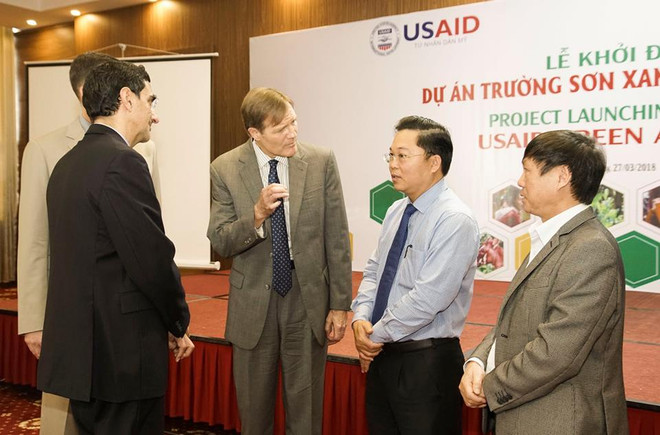 USAID Vietnam Mission Director Michael Greene talks with leaders of Quang Nam province at the ceremony to launch the USAID Green Annamites Project on March 27. (Photo: USAID Vietnam)
USAID Vietnam Mission Director Michael Greene talks with leaders of Quang Nam province at the ceremony to launch the USAID Green Annamites Project on March 27. (Photo: USAID Vietnam)Hanoi (VNA) – The United States Agency for InternationalDevelopment (USAID) launched the 24-million-USD Green Annamites Project in TamKy city, the central province of Quang Nam on March 27 to help it preservelocal biodiversity and improve people’s livelihoods.
The project aims to better manage more than 400,000 hectares of naturalforest and protect endangered plants and animals. It also looks to improve thelivelihoods of 20,000 forest-dependent people in Quang Nam and neighbouringThua Thien-Hue provinces.
The project will be carried out in 11 cities and districts of Quang Namuntil 2021 with total investment of more than 14 million USD.
Forests play a crucial role in Vietnamby protecting watersheds which slow soil erosion and alleviate climate change.Forests in the Annamites Range of Vietnam are home to rare and endemic species foundnowhere else in the world. However, inrecent times, these forests, and the species that live in them, aredisappearing at an alarming rate, as nearby communities increasingly depend onthese limited resources for their livelihoods.
In such context, the USAID Green AnnamitesProject will engage small-hold farmers and their families to boost livelihoodsand increase investment in climate-smart agriculture in Thua Thien-Hue andQuang Nam while maintaining the natural biodiversity of these provinces.
It will help the two target provincesreduce deforestation and forest degradation, and restore degraded landscapes.From partnering with the private sector, which sources materials from forestsand local farmers, to introducing improved farming practices and strengtheningmarket access, the project will help local forest-dependent communitiesdiversify and adopt sustainable livelihoods.
The project also includes actions forimproving forest conservation planning, increasing the knowledge and skills oflocal forest managers and decision makers and helping local communities live inharmony with protected forests.
Climate change directly threatensVietnam’s sustainable development goals. To accelerate its transition tolow-emission development, the country has collaborated with USAID to betterrespond to climate change through adaptation, sustainable landscapes and cleanenergy programmes in recent years.–VNS




























